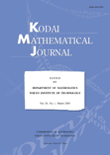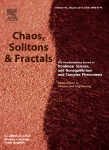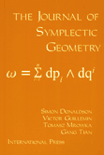
Journal of Fractal Geometry
Scope & Guideline
Championing Open Access to Fractal Insights
Introduction
Aims and Scopes
- Fractal Analysis and Dimension Theory:
The journal publishes research on various aspects of fractal dimensions, including Hausdorff, Assouad, and box dimensions, exploring their properties and applications in different mathematical contexts. - Iterated Function Systems (IFS):
A significant focus is placed on iterated function systems, which are used to construct fractals. The journal discusses both theoretical foundations and practical applications, such as the behavior of IFS under various conditions. - Geometric Properties of Fractals:
Research exploring the geometric characteristics of fractals, including self-similarity, fractal interpolation, and the topology of fractal sets, is a core area of interest. - Random Fractals and Measures:
The journal includes studies on random fractals and the associated measures, examining their statistical properties and implications in probability theory. - Applications of Fractal Geometry:
Papers often explore the applications of fractal geometry in various disciplines, such as physics, biology, and computer science, demonstrating the interdisciplinary relevance of the field.
Trending and Emerging
- Advanced Measure Theory in Fractal Contexts:
Recent publications show an increasing interest in complex measure-theoretic frameworks applied to fractals, such as the study of non-homogeneous self-similar measures and their properties. - Conformal and Non-autonomous Systems:
There is a growing trend towards exploring conformal iterated function systems and their applications, reflecting an interest in the dynamics and geometric properties of these systems. - Interdisciplinary Applications of Fractal Geometry:
Emerging themes include the application of fractal geometry in diverse fields such as physics (e.g., Liouville Brownian motion) and computer science, showcasing the utility of fractal concepts in solving complex real-world problems. - Higher Dimensional Fractal Structures:
Research on higher-dimensional fractal structures and their characteristics is trending, indicating a shift towards exploring more intricate and multi-dimensional fractals. - Numerical and Computational Approaches:
There is an increasing focus on numerical methods and computational techniques in studying fractals, suggesting a trend towards practical applications and simulations of fractal phenomena.
Declining or Waning
- Classical Fractal Construction Techniques:
There appears to be a reduction in papers focused on traditional methods of constructing fractals, such as the classical Cantor set or Sierpiński triangle, suggesting that researchers may be moving towards more complex or novel constructions. - Basic Theoretical Expositions:
Papers that provide basic theoretical overviews or introductory discussions on fractal geometry concepts have become less common, indicating a shift towards more specialized and advanced topics. - Fractal Applications in Simple Models:
The application of fractal geometry to simple or well-established models seems to be declining, as researchers increasingly seek to explore more complex systems and innovative applications.
Similar Journals

Kodai Mathematical Journal
Cultivating Knowledge in the Mathematical CommunityKodai Mathematical Journal is a distinguished publication dedicated to advancing the field of mathematics, particularly in miscellaneous areas. Established in 1949, this esteemed journal has been a reputable source for researchers and practitioners who seek to contribute to the rich landscape of mathematical knowledge. Published by KINOKUNIYA CO LTD, the journal is based in the academic environment of Tokyo Institute of Technology and serves a global audience with rigorous and insightful research articles. Despite its current Q3 quartile ranking in the Scopus Mathematics category, which reflects its niche but impactful contributions, the journal is poised for growth; the convergence of traditional and novel mathematical techniques promises to enhance its relevance further. Researchers, professionals, and students are encouraged to engage with the rich content of the journal, aimed at fostering collaboration and nurturing innovation in the mathematical community. While currently not available as Open Access, Kodai Mathematical Journal remains a critical resource for those passionate about mathematics and its applications.

Journal de l Ecole Polytechnique-Mathematiques
Exploring the Depths of Mathematical Innovation.Journal de l Ecole Polytechnique-Mathematiques, published by ECOLE POLYTECHNIQUE in France, stands out as a premier platform for disseminating cutting-edge research in the field of mathematics. With an impact factor reflective of its rigorous academic standards, the journal is categorized in the Q1 Quartile for Mathematics as of 2023, placing it among the top tier of scientific publications. Recognized for its strategic focus on various branches of mathematics, it holds a formidable position within Scopus, ranking 94th out of 399 in general mathematics. Since embracing the Open Access model in 2014, the journal has ensured that vital research findings are accessible to a global audience, thereby fostering collaboration and innovation. With convergence expected until 2024, the Journal de l Ecole Polytechnique-Mathematiques continues to be a significant contributor to the academic community, inspiring both seasoned researchers and emerging scholars from around the world.

HOUSTON JOURNAL OF MATHEMATICS
Fostering Innovation in Miscellaneous MathematicsHOUSTON JOURNAL OF MATHEMATICS, published by the University of Houston, serves as a valuable platform for disseminating significant findings in the field of mathematics, specifically within the realm of miscellaneous mathematics. Despite its current categorization in Q4 for 2023, the journal plays a crucial role in fostering academic discussion and exploration among researchers, professionals, and students alike. With its ISSN 0362-1588, the journal has been publishing original research since 1996, with a recent gap filled from 2022 to 2023, thereby continuing to contribute to the mathematical community. While it does not currently offer open access options, the journal's commitment to quality research maintains its relevance within the field and invites submissions that can elevate its standing. Located in the vibrant city of Houston, Texas, the journal not only emphasizes theoretical advancements but also encourages applied mathematical research that intersects with other disciplines, enhancing its significance and reach.

Revista Matematica Complutense
Championing High-Impact Research in MathematicsRevista Matematica Complutense is a prestigious peer-reviewed journal published by SPRINGER-VERLAG ITALIA SRL, specializing in the field of mathematics. With its ISSN 1139-1138 and E-ISSN 1988-2807, the journal plays a vital role in disseminating high-quality research and fostering academic discussion within the mathematics community. Recognized for its rigorous selection process, the journal has achieved impressive rankings, holding a Q1 quartile status in the miscellaneous mathematics category as of 2023 and ranking #94 out of 399 in general mathematics according to Scopus, placing it within the 76th percentile. With a publication timeline spanning from 2008 to 2024, the Revista Matematica Complutense continues to serve as an essential resource for researchers, professionals, and students alike. Although it does not currently offer open access, the journal remains committed to advancing mathematical knowledge and providing a platform for innovative research across various mathematical disciplines.

CHAOS SOLITONS & FRACTALS
Pioneering Research at the Intersection of Chaos and MathematicsCHAOS SOLITONS & FRACTALS, published by Pergamon-Elsevier Science Ltd, stands as a premier journal in the fields of mathematical physics, applied mathematics, and nonlinear dynamics. With an impressive impact factor and a 2023 ranking placing it in the Q1 quartile for both applied mathematics and mathematical physics, this journal serves as an essential platform for groundbreaking research and innovative theories that explore the complex interplay between chaos, solitons, and fractal structures. Established in 1991 and converging research until 2024, the journal features rigorous peer-reviewed articles that appeal to academics, professionals, and students alike, facilitating the dissemination of knowledge within a community passionate about statistical and nonlinear physics. Although not open access, its rich content is critical for those seeking to deepen their understanding and advance their work in these dynamic and multifaceted areas of study.

European Journal of Mathematics
Bridging Theory and Practice in MathematicsWelcome to the European Journal of Mathematics, a prominent publication that serves as a vital platform for disseminating high-quality research in the field of mathematics. Published by Springer International Publishing AG, this journal has witnessed significant growth since its inception in 2015 and is recognized for its contributions within the Q2 category of Mathematics (miscellaneous) as per the 2023 rankings. With an ISSN of 2199-675X and an E-ISSN of 2199-6768, the journal aims to foster innovation and collaboration among researchers, professionals, and students alike. Although it operates under a traditional access model, the journal's commitment to advancing mathematical knowledge and applications cannot be overstated. Positioned among the top-tier publications, the European Journal of Mathematics is an essential resource that encourages the exploration of emerging trends and theories in mathematics, making it indispensable for anyone striving to stay at the forefront of this dynamic field.

Journal of Symplectic Geometry
Fostering collaboration in the realm of geometry and topology.Journal of Symplectic Geometry, published by INT PRESS BOSTON, INC, is a premier outlet for research in the rapidly evolving fields of geometry and topology. With an ISSN of 1527-5256 and an E-ISSN of 1540-2347, this journal has established itself as a vital resource for scholars, featuring innovative research and comprehensive surveys that delve into the intricacies of symplectic geometry and its myriad applications. Boasting an impressive Q1 ranking in Geometry and Topology for 2023, the journal is dedicated to fostering a collaborative academic environment, attracting contributions from esteemed mathematicians worldwide. While the journal maintains a subscription-based model, it continues to prioritize disseminating high-quality research that propels advancements in the field. Researchers, professionals, and students alike will find the Journal of Symplectic Geometry indispensable for staying updated on the latest developments and contributing to ongoing discussions within the symplectic community, spanning from 2009 to 2024.

International Electronic Journal of Geometry
Fostering Innovation in Mathematical ResearchWelcome to the International Electronic Journal of Geometry, an esteemed platform dedicated to the dissemination of high-quality research in the fields of geometry, applied mathematics, and mathematical physics. Published by the INT ELECTRONIC JOURNAL GEOMETRY based in Ankara, Turkey, this journal serves as a crucial resource for scholars and practitioners eager to contribute to and stay informed on contemporary advancements in these disciplines. While currently categorized in the Q4 Quartile across multiple mathematical categories, the journal has consistently focused on fostering innovative research and providing open access to its content, although specific access options may vary. The International Electronic Journal of Geometry is known for facilitating scholarly dialogue and collaboration, aiming to enhance knowledge exchange within the global mathematical community from 2019 into the future. Whether through rigorous research articles or insightful commentary, this journal plays a vital role in promoting the understanding and application of geometric concepts and mathematical principles.

FRACTALS-COMPLEX GEOMETRY PATTERNS AND SCALING IN NATURE AND SOCIETY
Exploring the Intricacies of Nature and Society Through Fractal GeometryFRACTALS: COMPLEX GEOMETRY, PATTERNS AND SCALING IN NATURE AND SOCIETY, published by World Scientific Publishing Company, is a pioneering journal in the fields of applied mathematics, geometry and topology, modeling and simulation, and multidisciplinary studies. Now celebrating nearly three decades since its inception in 1995, this esteemed publication boasts significant rankings, including Q1 status in Multidisciplinary research and Q2 rankings in Applied Mathematics, Geometry and Topology, and Modeling and Simulation for 2023. Researchers and professionals in the domains of complex systems, fractal geometry, and their applications will find this journal to be a vital resource that bridges theoretical mathematics and practical applications across various disciplines. With a commitment to disseminating cutting-edge findings and fostering interdisciplinary collaboration, FRACTALS plays an essential role in advancing knowledge that reflects the intricate patterns present in both nature and society.

ADVANCES IN GEOMETRY
Fostering Connections in the World of GeometryADVANCES IN GEOMETRY is an esteemed journal dedicated to the dissemination of innovative research in the field of geometry and topology. Published by WALTER DE GRUYTER GMBH, this journal serves as a vital platform for researchers and practitioners from around the globe, reflecting the latest advancements and stimulating critical discussions in the subject. With an ISSN of 1615-715X and an E-ISSN of 1615-7168, it enjoys a reputable standing, evidenced by its classification in the Q3 category of the geometry and topology domain according to 2023 metrics. Although the journal operates under standard access options, it is committed to fostering scholarly communication and raising the visibility of high-quality research. The journal's impact on the field is underscored by its Scopus rank of #77 out of 106, placing it in the 27th percentile. Since its inception in 2001, ADVANCES IN GEOMETRY has continually blossomed, promising a convergence of ideas and methodologies that drive forward the understanding of geometric theory. This journal is essential reading for those eager to stay at the forefront of geometry and topology research.